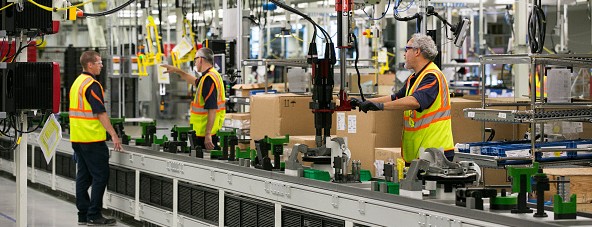This is an original article written by Lydia O'Neal.

- Proposed rules reduce limit for manufacturers, distributors
- Tax professionals expect lobbying push to ensue
Leveraged companies are dreading 2022. Unless the IRS changes its recently proposed rules for a major 2017 tax overhaul revenue raiser, debt-financed manufacturers will dread filing taxes for 2018, 2019, 2020, and 2021 as well.
Get ready for an industry lobbying storm.
“I would expect a significant pushback on this” from the tax and accounting profession and the manufacturing industry, said Al Cappelloni, a tax partner at RSM US LLP in Boston, who said he first heard of the issue from a dismayed manufacturer client. “It’s going to have a large impact.”
The law put a cap on the amount of debt interest payments companies can use to reduce the amount of their income that’s subject to federal tax, under amended tax code Section 163(j).
Before the tax law, corporations could generally count on shrinking their tax liabilities by an amount equal to their full interest payments, but now they can only use an amount equal to 30 percent of earnings before interest, taxes, depreciation, and amortization (EBITDA).
Starting in 2022, companies can’t add depreciation and amortization back into the income measure they use to calculate the 30 percent cap, so the number of leveraged corporations affected by the provision will expand substantially. In quantitative terms, the interest write-off cap is expected to pull in nearly twice as much revenue in the four years after that switch than it is expected to raise beforehand, according to the Joint Committee on Taxation.
The new restriction is especially troubling given the sheer volume of U.S. corporate debt—for nonfinancial companies, it topped $6.2 trillion this year, according to Federal Reserve data. The limit applies to interest arising in tax years starting in 2018 on debt corporations already have. For leveraged companies, particularly those with relatively less income, it effectively makes that debt far more expensive—a serious consequence amid rising interest rates.
For manufacturers, however, the smaller cap expected to go into effect in 2022 may as well already be here.
‘EBIT for Manufacturers’
In proposed rules (REG-106089-18) for amended Section 163(j) issued Nov. 26, the Internal Revenue Service said that for costs companies incur as depreciation—an accounting benefit used to recover the cost of a capital purchase through tax breaks—but that are allocated to inventory and included in the cost of the goods sold, the depreciation can’t be added back into the income, or EBITDA, amount.
Almost everything manufacturers and distributors purchase fits the definition of inventory or cost of goods sold, so for them, the shift from EBITDA to just earnings before interest and taxes (EBIT) might as well have happened already, tax professionals said.
“It’s EBIT for manufacturers,” said Glen Birnbaum, a CPA at Heinold Banwart Ltd. in East Peoria, Ill., who works with mid-market businesses and said his firm would surely be writing a comment letter on the issue. While Birnbaum said he had his hopes up for “some better rules,” he pointed out that businesses still have tax payments to make in the meantime.
The interest write-off restriction generally only applies to companies with annual gross receipts above $25 million, so only large and mid-size companies are affected. But those fresh off a leveraged buyout or that are in their earlier growth stages—with a lot of debt and little income for calculating that 30 percent cap—are likely to face higher-than-anticipated tax bills.
Either way, capital “is the lifeblood of manufacturing,” Chris Netram, vice president of tax and economic policy at the National Association of Manufacturers, said in a statement to Bloomberg Tax. Congress clearly intended to support capital-intensive industries when it modified the tax treatment of interest payments,” he added, so “the law should be applied in a manner consistent with this intent.”
Speaking of congressional intent: Another part of the 2017 law that amends tax code Section 168(k) actually incentivizes the purchase of more capital. By pushing manufacturers to ramp up investments, purchases instigated by a more business-friendly provision could exacerbate what was to many an unpleasant surprise from the IRS, tax professionals said.
They might buy a bunch of equipment to build their products with debt, for instance, and expect to be able to write off the cost of the purchases immediately and then write off all their interest payments on the debt as well. But if the capital purchases aren’t added back into income, the 30 percent ceiling on interest deductions could leave them with a substantially higher tax liability.
Brian Murphy, a tax partner at Grant Thornton LLP in Chicago who focuses on consumer and industrial products, recalled a NAM meeting earlier in December in which tax directors expressed their consternation over this element of the proposed rules.
The tax directors, he said, “thought it was somewhat arbitrary” and possibly an attempt to meet revenue expectations for amended Section 163(j), which the JCT projected will raise $253.4 billion between 2018 and 2027.
The IRS didn’t comment by press time. A Treasury Department official said in a statement provided by a spokesperson that “the proposed rule follows the statute” and that the department has “received comments on this issue, which we will consider as we work on finalizing the regulations in 2019.”
“On the other hand, there’s logic to what they did. Cost of goods sold is different from depreciation,” Murphy said. “There may be a camp that anticipated it. Those that are upset by it are more vocal.”
Industry Lobby to Switch Gears
Lobbyists across industries have said they have their eyes on the switch in the income measure from EBITDA to EBIT in 2022, with plans to stop it from happening.
Manufacturing industry advocates will soon turn their resources toward the IRS regulations, however. Tax and industry professionals expect a revival of the lobbying effort that kept the Senate’s proposal to put an EBIT-based limit into the law right off the bat and kept the percentage cap at 30, as opposed to, say, zero.
But not quite yet. Plenty likely haven’t even noticed or accounted for the significance of those four lines in the 439 pages of regulations—or perhaps missed another brief reference in the rules’ preamble—even weeks after the package’s release.
“It may be that people haven’t realized the full extent of this,” said David Zimmerman, a member of Miller & Chevalier Chartered in Washington who focuses on corporate financing, among other federal tax matters. Corporations are still working to reconcile the impact of other byzantine tax overhaul provisions, such as the base erosion and anti-abuse tax and the levy on global intangible low-taxed income, he said.
Once the pushback gains momentum, however, it’s unclear whether the IRS and Treasury will budge, Zimmerman and others said.
“If you look at the code, cost of goods sold—and this is getting hyper-technical—it’s not a deduction, it’s a reduction of income,” said RSM’s Cappelloni. “The terminology” in the statute “is you add back deductions.”
View the original article here.




